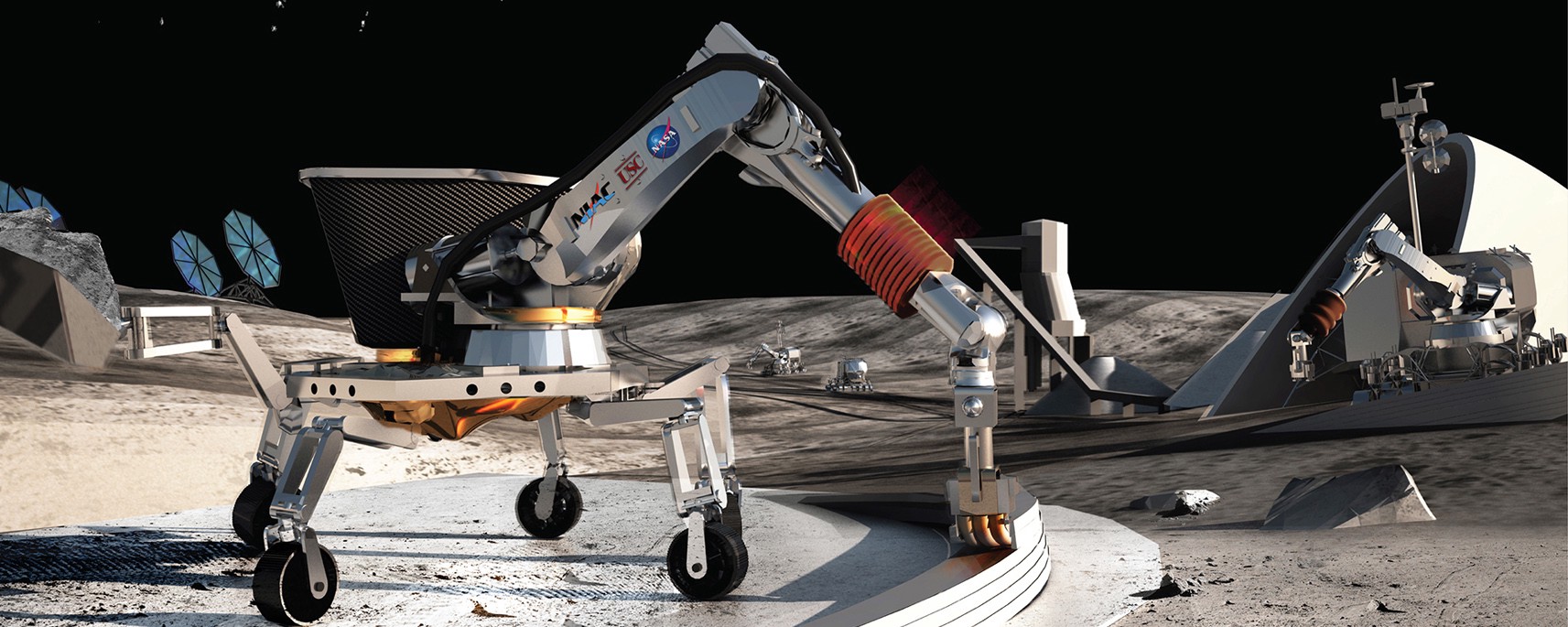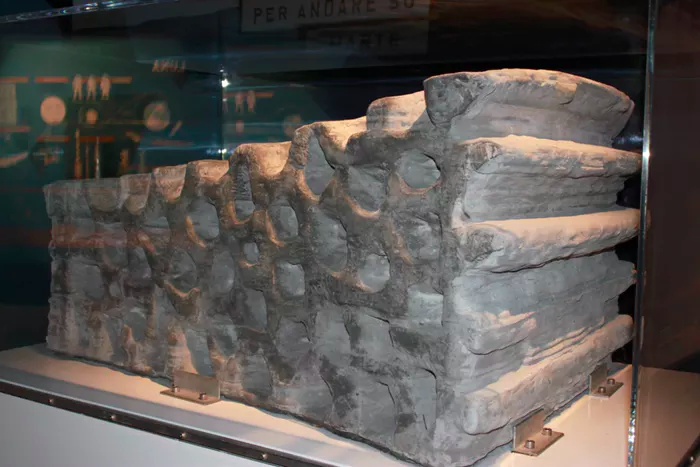

*click* – You just submitted your payment for your first house in space. Exciting. A progress bar shows up on your screen, as a live feed from the Moon begins. You watch robots crawl into view as they begin to construct your home. They’re assembling bricks made of dust, inflating a living space for you, and constructing an area to grow crops. Time remaining: three Earth days.
When it comes to building property on other worlds, robots are by far the best choice. While humans explore the final frontier, robots will do their dirty work–hauling, heaving, and hefting everything into place to make their stay a comfortable one.
All of the technology we need to robotically build homes exists right now here on Earth, and plans are moving forward to use it in space. We’re seeing 3D-printed houses, brick-laying robots, and robots that can assemble blocks into any 3D model. What we see on Earth today will be out in space tomorrow.
There are plenty of good, logistical reasons why it doesn’t make sense for humans to do the construction work. If you were going to build on another planet, you would need your own temporary habitat to stay in while work on your permanent residency takes place. You’d need your own food supply for however long you took to construct it. While building, you’d face the hazards of space, such as meteorites and radiation, and you also wouldn’t have the benefit of being able to work continuously without rest.
All of these things add up to a lot of extra risk that could be avoided by letting robots do the construction–but more importantly, it means saving weight. It’s vital to avoid unnecessary weight because the farther in space you wish to go, the less our rockets are able to carry, and the more expensive the price-per-pound becomes.
For instance, on SpaceX’s most powerful rocket–the Falcon Heavy–the cost to put something into low Earth orbit is $750 per pound (0.45 kilograms), but the cost per pound to send something to Mars is $3,002 dollars. This is because the capability of the rocket decreases significantly over distance. While the Falcon Heavy can bring 119,930 pounds (54,400 kilograms) into low Earth orbit, it can only bring 29,980 pounds (13,600 kilograms) to Mars. The farther we wish to go, the less we can bring.
In light of these weight restrictions, it makes sense to use robots to build our space houses. Without the need to send humans, we can densely pack our spacecraft with robots and tightly packed construction materials. No life-support systems would be necessary on such a shuttle, which maximizes the amount of material we can send.
If the soil is friendly enough, robots can also autonomously grow crops in space; and if not, we can at least send a load of food up with them in preparation for our arrival. Again, less food on the shuttle means more people, lowering the cost of travel split between everyone.

There are many ways in which a home on Mars would differ from one on Earth, but probably the most important is a protective membrane to hold the air in.
For this, it makes sense to use inflatable structures–to compress, pack, and then inflate them once they’re up there has benefits over sending up a pre-constructed, voluminous habitat. The European Space Agency has been exploring just such a possibility. It’s looking to inflate a habitat, and then use the regolith on the Moon as a material to 3D-print bricks for surrounding the membrane. These 3D-printed bricks would be necessary to protect the membrane from radiation and space debris.

There are several options for getting that protective shell in place. One company in China has created a 3D printer for houses that can print the floors and walls of 10 structures in a day using construction waste. Another company has made a 3D printer that can print a home out of clay. This robot from FastBrick can lay the bricks for a 3D model of a house just as a human worker would.
Other researchers are taking an approach inspired by nature. Robots developed at Harvard use an algorithm based on the cooperation between termites to build uploaded structures together from the bottom up.
FastBrick’s crane-like robot could easily drop 3D-printed bricks into their necessary space, and make quick fixes without a problem. But I favor the very small size of the termite robots–the lunar dust makes for a lighter building material than a standard construction brick, and the gravity is one-sixth that of Earth’s. We won’t need a massive machine to do the work. The robots can be smaller and weaker.

Food is a major concern, and it’s probably the part of the plan that needs the most work. While the crop-raising robot FarmBot looks promising with its efficiency, autonomy, and precision in planting and growing crops, the real issue is getting the nutrients into space that can grow the plants. The lunar soil lacks nitrogen–we’ll need to send up fertilizer.
As for Mars, it turns out the Martian soil has enough nutrients to successfully grow crops. A study done in the Netherlands showed that a soil extremely similar to the Martial regolith was able to grow crops fully. The local soil at the landing point will vary somewhat, but as long as the nutrients are on the planet, robots could go out to scavenge for them.
But there is one danger in the Martian soil that does not exist in the lunar soil. It has been discovered that up to one percent of the Martian soil consists of perchlorates, which block the absorption of iodine–a vital function in the human metabolic system. Consuming too much could produce drastic changes in mood, appetite, temperature regulation, sleep cycles, and more. The good news is that perchlorates are soluble and can be washed away, so it may be possible to process the soil and limit exposure. They can also be used to help produce oxygen, and are useful in rocket fuel as well due to their stability in low temperatures and explosiveness in high temperatures.

Finally, there’s the issue of location. In real estate, location is the most important thing, and that doesn’t change when you get to space. Pick the wrong spot, and you could end up with extreme heat and extreme cold. It’s hard to find a good location on the Moon–almost any spot you pick will have 14 Earth-days of night and 14 Earth-days of day. On Mars, some regions are prone to dust storms that block out solar panels.
The most important concerns when it comes to choosing a location are nutrients, water, and energy. Wherever you live, you will need these three things. Ice, and therefore attainable water, is more likely to be found at the poles of a planet, but these areas have much less sunlight. Powering a human habitat on solar power alone in these extreme regions would currently be impossible. Meanwhile, staying on the equator of a body like our Moon would bring about temperature swings as wide-ranging as 392° F to -328° F (200° C to -200° C).
With proper insulation, however, the temperature ranges aren’t the biggest issue–it would be keeping the habitat and robots powered for 14 days of darkness. One solution would be to send up larger battery packs and solar arrays, but until battery life improves a more reliable method might be to use a nuclear generator. Currently, there’s a nuclear-powered rover traveling on Mars–so it’s more than possible–but it would require some tweaking of international laws limiting nuclear material on rockets.

Plans are moving fast. The Japan Aerospace Exploration Agency (JAXA) is already going forward with proposals to use robots to build habitats for four to six people on the Moon by 2030, and to build them on Mars by 2040. It’s partnering with Japanese construction company Kajima–which has already used autonomous vehicles to build dams–to construct these habitats. While the European Space Agency is exploring using 3D printers to build a moonbase, and NASA held a recent competition to come up with designs for such a habitat, Japan’s plans are the most concrete so far.
While the challenges of water, energy, and nutrients may make extraterrestrial construction seem far off, improving battery life, AI, and construction robots makes it more feasible than most people realize. This is an innovation we will see in our lifetimes, and one that is necessary to enable us to go to infinity and beyond.
Your house is finished. As your spacecraft begins to launch, you think about the significance of this journey. While your new home may lack the luxuries of Earth, you understand it as your duty and destiny to live amongst the stars. You wave goodbye to your home planet, and enter into a new interplanetary era.


How We Get To Next was a magazine that explored the future of science, technology, and culture from 2014 to 2019. This article is part of our Above & Beyond section, which looks at our understanding of the universe beyond Earth. Click the logo to read more.
